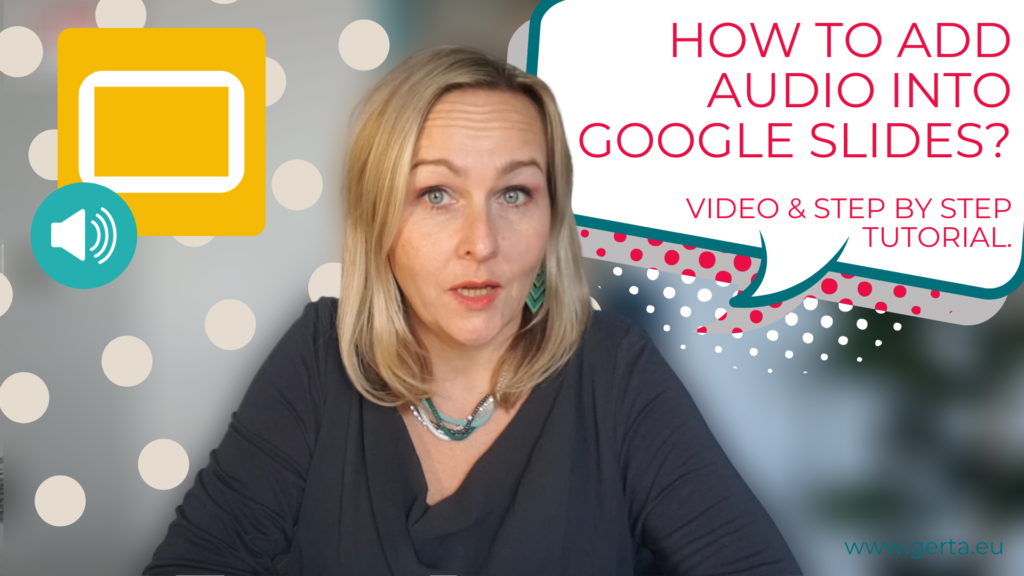Adding audio is a great way to keep your slides and as a result – the learning experience more engaging and personalised. You might want to insert audio into google slides for many reasons. For example – to add narration, a piece of background music or even some sound effects. In this post, I will show you how to insert audio into Google slides.
You can watch the tutorial video or read the post below.Other posts about Google Slides you might be interested in:
- Audio and voiceover in Google slides – why and how to use it?
- How to insert audio into Google Slides? Video and step by step tutorial.
- How to play Audio in Google Slides in editing and presenter mode
- How to test your slides before publishing to the web?
- How to share your google slides with the audience? Publishing and embedding slides.
WATCH THE VIDEO EXPLAINING HOW TO ADD AUDIO INTO GOOGLE SLIDES
HOW TO INSERT AN AUDIO FILE INTO GOOGLE SLIDES
The range and the capability of Google tools are impressive. You can collaborate online in real-time creating documents, spreadsheets and slides and see changes instantly. You can also store other formats like audio, video, and images, but they cannot be created within the drive, but rather uploaded.
So before getting into step by step guide, I wanted to note that Google doesn’t allow creating the audio file itself (at the time of writing this and recording this video) so I explain how to INSERT video into google slides. Hopefully, the option to record directly into slides will come soon.STEP 1:
CREATE AND RECORD YOUR AUDIO FILE OR SOURCE EXTERNAL FILES
- Voice recorder on your phone (all smartphones have a built in app)
- Online Voice Recorder (web-based, no sign-in required) or
- Audacity (I do recommend Audacity. If you record a lot, it will allow you to control the quality, input levels and adding metadata. And of course, you can use it to edit your files).
STEP 2:
SAVE YOUR AUDIO ON YOUR LAPTOP OR IN G DRIVE.
Make sure to change your audio sharing settings to ‘shared’. This is important. If you are planning to share your slide deck with your students or visitors on your website and want them to be able to play or hear the audio file, the audio has to be shared. Think about audio as another file added to your presentation. It is not enough to share the presentation – you will need to share the audio files too.
- Right-click on the audio file from Google Drive, and click on Share.
- Go to ‘Get link’ window, and make sure that the file is shared with anyone with the link (only this way people from outside your organisation will be able to play the audio).
STEP 3:
INSERT AUDIO INTO YOUR GOOGLE SLIDE
STEP 4:
ADJUST THE AUDIO SETTINGS
Click on the Format option from the top menu – the side options menu should open on the right hand side.
From here you can change the settings of the inserted audio clip. For example, you can set it to autoplay when the slide loads, or play audio only when the viewer clicks on it. If it is background music, you might want to loop your audio or hide the speaker icon all together for the time you are presenting. You can also change other settings such as icon position, colour, transparency and other adjustments.
Make sure to test your slides before publishing them to the web! You might discover that some files are not appearing because their sharing settings have not been changed.
If you want to learn more about the Google Slides, check out my Google Slides mini-series on Youtube (make sure to subscribe to get notifications about new videos).
You can also express your interest in Google Slides for education and communication boot camp I am designing. This course is perfect for beginner to intermediate users to take their skills to the next level and become a Google Slides Ninja!




JOIN MY NETWORK, STAY CONNECTED, GET IN TOUCH!
JOIN MY NETWORK!
RELATED POSTS
8 types of learning infographics to create engaging learning experiences
15 learning design mistakes you should avoid when creating online courses